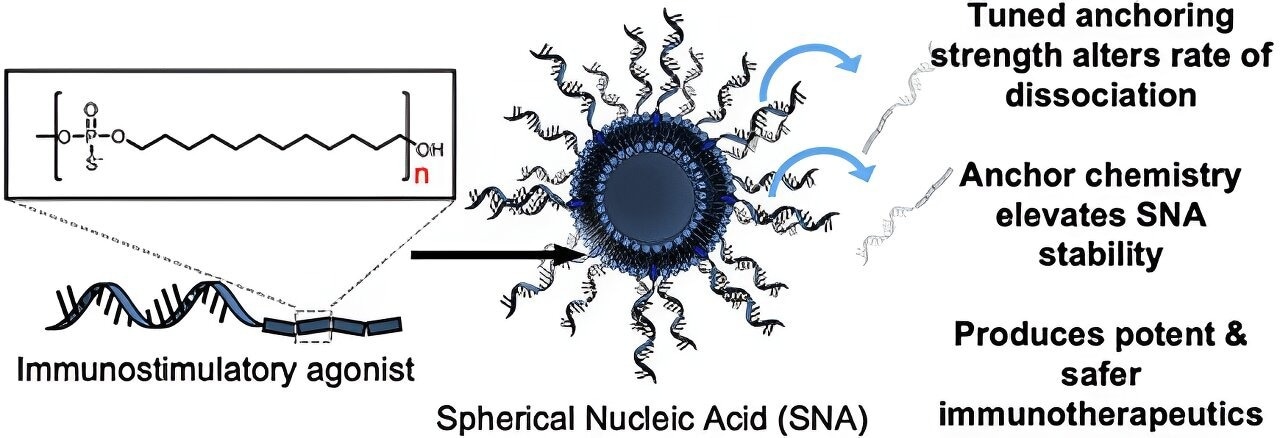Researchers from Northwestern Medicine have reported in ACS Nano that they have improved the process of producing vaccinations and medications using nanotherapeutics.

Image Credit: ACS Nano (2023). DOI: 10.1021/acsnano.3c04333
Over the last decade, spherical nucleic acid, or SNA, technology has emerged as a broad therapeutic platform for a wide variety of diseases, including cancer and other illnesses.
Chad Mirkin, PhD, Study Lead Author and George B. Rathmann Professor, Chemistry, Weinberg College of Arts and Sciences, Northwestern University
Through a methodical development approach called rational vaccinology, researchers in the Mirkin group have utilized this SNA technology in their work to produce precision nanomedicines for application in gene regulation and cancer immunotherapy with minimal unfavorable side effects.
Mirkin added, “In the development of vaccines, historically, very little attention has been paid to vaccine structure. All of the emphasis has been on the components. The premise of rational vaccinology is that, while components are critical, structure is equally important. How you present vaccine components within a modular nanoscale architecture can have a dramatic impact on vaccine efficacy, whether it's treating infectious disease or cancer.”
The study's first experiment examined the impact of attaching oligonucleotides—short strands of DNA or RNA—to the liposomes’ surface using various chemical anchoring groups to create SNAs. The stability of the nanostructure was shown to be significantly improved by applying progressively hydrophobic dodecane-based anchoring groups.
When given to bone marrow-derived dendritic cells from mice, these more stable SNA constructions demonstrated enhanced cellular uptake compared to previous forms of SNAs made with other anchoring groups and chemistries.
We discovered a way to anchor the oligonucleotides to the surface of the particle that changes the overall stability of the SNA construct, which is critical. The beauty of the SNA architecture is that it's recognized by almost all cell types, immune cells included, and rapidly internalized. You get the vaccine to enter the cells that matter at the stoichiometry you'd like, with the desired number of antigens and adjuvant molecules.
Jasper Dittmar, Study Co-Author and PhD Student, Northwestern University
The Mirkin lab subsequently loaded the SNA vaccine with OVA1 (a model peptide generated from egg protein that is frequently used in vaccine research) and administered it to lymphoma-infected animals.
According to the study, OVA1 SNA-treated animals not only had a higher number of polyfunctional T-cells (which are thought to be strong against chronic infections and cancers), but they also exhibited a 21-fold reduction in tumor sizes compared to saline-treated mice.
The SNA was then examined to see if it stimulated excessive immune responses in mice to assess the vaccine’s inflammatory adverse effects. The medication did not cause a cytokine storm, a potentially lethal side effect of immunotherapies.
Since severe COVID-19 cases are linked to cytokine storms, Mirkin and his research team also developed an SNA vaccine in which the OVA1 peptide was replaced with a peptide from the COVID-19 virus (CoV peptide), which was then given to human cells and eventually mice. The vaccine, the researchers discovered, had few negative side effects and improved antigen-specific, anti-COVID immune responses.
Taken together, the results of this study lay a foundation for a new way of developing and delivering vaccines and other precision treatments, regardless of the target disease.
Michael Evangelopoulos, Study Co-Author and PhD Student, Northwestern University
According to Mirkin, the results further underscore the significance of vaccine development.
“Structure matters. In a field where we've spent very little time focused on the structure of vaccines, we have may have been missing the forest for the trees. It's a combined understanding of the components and the structural presentation that leads to an efficacious medicine or not,” Mirkin added.
According to him, the Mirkin group will keep developing various SNA vaccination settings to determine which are the most successful.
“We are spending a lot of time using the SNA platform to figure out the structures that are the most efficacious, and then trying to figure out why that is, what works and then also why it works. We think that by doing that, we'll be able to create a whole new generation of medicines based upon this concept of rational vaccinology,” Mirkin concluded.
Journal Reference:
Dittmar, J. W., et al. (2023) Tuning DNA Dissociation from Spherical Nucleic Acids for Enhanced Immunostimulation. ACS Nano. doi:10.1021/acsnano.3c04333